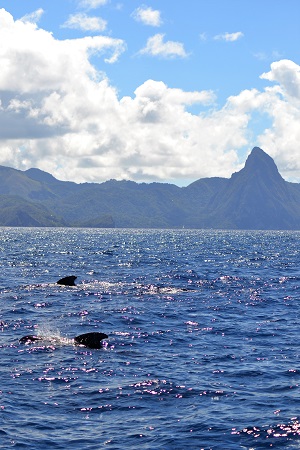Home | Tours | Trip Reports | News | Team | Calendar | Links | Contact | Store | Mailing List

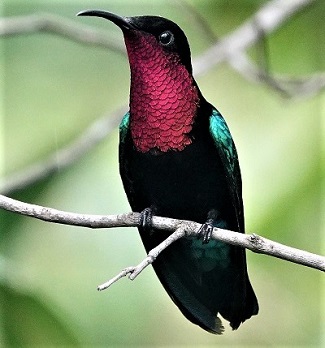 LESSER
ANTILLES
LESSER
ANTILLES 10 ISLAND ENDEMIC BIRDING TOUR
January 11 - 24, 2027
Contact gina@sunrisebirding.com to reserve!
Antigua,
Barbados,
Barbuda,
Dominica,
Grenada,
Guadeloupe,
Martinique,
Montserrat,
St.
Lucia and St.
Vincent
Some Highlights & Specialties of the Islands>
2023 Trip Report> 2024 Trip Report>
Itinerary> Trip
Cost> Tour
Registration
&
Terms>
The Lesser Antilles are long series of islands extending north to south between the Atlantic Ocean and the Caribbean Sea. For birders, these islands hold some truly superlative species including more than thirty Lesser Antilles endemics and forty-five Caribbean specialties. On this "Every Endemic" birding tour, we target them all and sample the diverse nature and culture of the Lesser Antilles. Using a combination of air and sea, we'll travel to each island in search of the avian specialties to be found on these 10 magical islands: Antigua, Barbados, Barbuda, Dominica, Grenada, Guadeloupe, Martinique, Montserrat, St. Lucia, and St. Vincent.
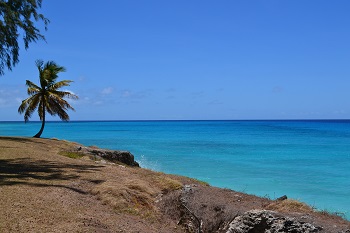 Each
of the stunningly
beautiful Caribbean
islands of the Lesser
Antilles is separated
by sparkling turquoise
seas and has rich
wetlands, open
grasslands, dynamic
coastlines and lush
tropical rainforests.
These diverse and
varied habitats are
home to a lengthy
list of highly-threatened,
single-island endemics
and near endemics,
along with a host
of indigenous regional
specialities unique
to the southern Caribbean.
Each
of the stunningly
beautiful Caribbean
islands of the Lesser
Antilles is separated
by sparkling turquoise
seas and has rich
wetlands, open
grasslands, dynamic
coastlines and lush
tropical rainforests.
These diverse and
varied habitats are
home to a lengthy
list of highly-threatened,
single-island endemics
and near endemics,
along with a host
of indigenous regional
specialities unique
to the southern Caribbean.
We’ll
target stunning and many
critically endangered
single-island endemics
and range-restricted
regional endemics
such as the Whistling
Warbler in
St. Vincent; the
majestic Imperial
Amazon in
Dominica; the
dazzling Purple-throated
Carib (Above
photo:
Mark Greenfield) and
bemusing
Grey
Trembler on
St. Lucia; the
flame-breasted
Montserrat
Oriole on
the “Other
Emerald Isle”;
the lovely endemic
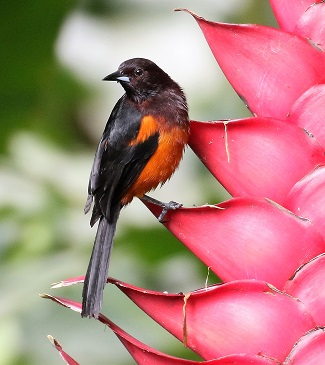 Martinique
Oriole (Photo:
Beatrice
Henricot); and
rarest
of
them all,
the
gentle, unassuming
Grenada
Dove,
still found serenely
walking the pathways
in the only area
of suitable habitat
remaining on the “Spice
Isle” of
Grenada.
Martinique
Oriole (Photo:
Beatrice
Henricot); and
rarest
of
them all,
the
gentle, unassuming
Grenada
Dove,
still found serenely
walking the pathways
in the only area
of suitable habitat
remaining on the “Spice
Isle” of
Grenada.
Nature abounds on the islands and we’ll enjoy butterflies, lizards, lush tropical plants and experience a range of Caribbean flora and fauna. We also have the potential for encounters with whales, dolphins,and marine turtles while crossing the crystal clear waters between islands. And, we’ll do all this while traveling to some of the most sought-after holiday destinations on the planet.
This truly is an epic and truly unique birding adventure tailor-made for our group. It is sure to yield spectacular sightings and leave you with long-lasting memories. The fact that this region has long remained off the birding map means that there is continuing discussion about numerous species splits. Now being researched and/or proposed for future classification, the birds you see on this trip have the potential to keep on giving for years to come!
Join
us for a Caribbean
birding adventure
in
the Lesser
Antilles!
Itinerary> Trip Cost> Tour Registration & Terms>
|
|||||||
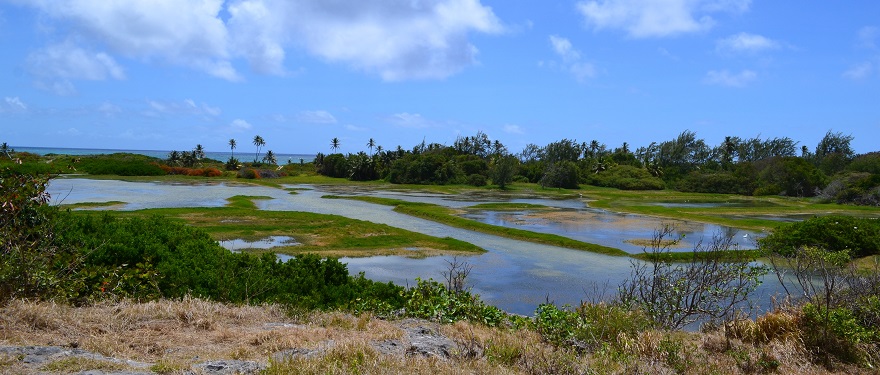
Marsh
by the Sea in Barbados.
Photo
by Ryan Chenery.
ITINERARY
Please note that the itinerary is subject to change depending on flight and ferry schedules. We'll visit all of the areas described below, but perhaps in a different order.
Day
1: ARRIVAL BARBADOS
Plan
on arriving in Bridgetown,
Barbados in the morning
today
at Grantley Adams International
Airport (Airport code:
BGI). We will be met by
our local guide on his native
island of Barbados and
taken to your beachfront
accommodation.
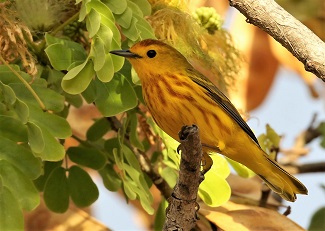 A
mere 10 minutes drive from
our hotel is the internationally-renowned
Graeme Hall Nature Reserve.
This sprawling 240-acre
wetland protects the last
remaining mangrove forest
on Barbados. For the last
10 years, the reserve has
been closed to the public;
however as former chief
naturalist for the reserve,
our local guide has arranged
exclusive access for our
group to this serene setting
and species-rich site.
A
mere 10 minutes drive from
our hotel is the internationally-renowned
Graeme Hall Nature Reserve.
This sprawling 240-acre
wetland protects the last
remaining mangrove forest
on Barbados. For the last
10 years, the reserve has
been closed to the public;
however as former chief
naturalist for the reserve,
our local guide has arranged
exclusive access for our
group to this serene setting
and species-rich site.
We meander along the trails of the Reserve surrounded by the verdant greens of mature Red as well as Green mangroves, their dense canopies the favored perches of many of the island’s unique species, including the nominate race of Golden Warbler (Photo: Beatrice Henricot), the recently split Barbados Grackle, and of course, the Barbados Bullfinch.
The
long dangling aerial roots
of Rhizophora
mangle line
the trails and provide
shelter for skulking
Green Herons and are  the
preferred runways for
Barbados Anoles and armies
of Fiddler Crabs. While
in the wetland we will
also have excellent opportunities
for views of feeding Grey
Kingbirds as
well as up-close encounters
with the endemic subspecies
of Antillean
Crested Hummingbird (Photo:
Keith Clarkson),
and
spectacular Green-throated
Carib (two
of the four hummingbirds
we target on our
travels through
the island chain).
This is also prime
habitat for troops
of Green
Vervets (Barbados "Green" Monkey).
the
preferred runways for
Barbados Anoles and armies
of Fiddler Crabs. While
in the wetland we will
also have excellent opportunities
for views of feeding Grey
Kingbirds as
well as up-close encounters
with the endemic subspecies
of Antillean
Crested Hummingbird (Photo:
Keith Clarkson),
and
spectacular Green-throated
Carib (two
of the four hummingbirds
we target on our
travels through
the island chain).
This is also prime
habitat for troops
of Green
Vervets (Barbados "Green" Monkey).
At
dusk, the West Indian Mahogany
Trees that surround our
hotel are filled with the
calls of Scaly-naped
Pigeons selecting
their favored roosts
and the fluttering wings
of Velvety
Free-tailed Bats (also
called Pallas's Mastiff
Bat), and the regional
endemic Myotis
nyctor setting out to feed.
Food is also on our
minds as we step down
from our hotel onto the
gleaming white sands
that line the southern
coastline
of the island and enjoy
a sunset stroll along
the beach to Oistins
fishing village - where
we tuck into a delicious
dinner of freshly caught
grilled fish, shrimp or lobster (other meats
plus vegetarian options
also available).
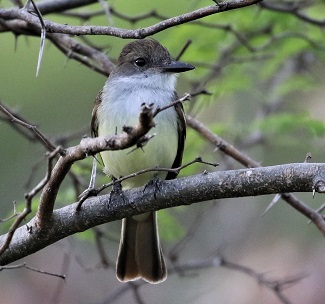 Day
2 – ST.
VINCENT
Day
2 – ST.
VINCENT
The
Lesser Antilles is
comprised of a chain
of largely submerged
mountains running north
to south in a double
arc. The outer arc from
Anguilla to Barbados
comprises low, flat
islands with limestone
surfaces, while the
inner arc is made up
of a series of volcanic
cones. The lush, heavily
forested volcanic island
of St. Vincent with
her largely black-sand
beaches and vast sprawling
wilderness is the first
island we explore within
this inner arc.
Arriving at the recently built international airport we are collected by pre-arranged transport and head into the lush primary rainforests of towering Mt. Soufriere. Here we will bird along forest paths lined with wild Begonia to the best sites to see the critically endangered Whistling Warbler (one of four single-island endemic species of warbler in the region), along with a wonderful selection of near endemics and indigenous regional species such as Grenada Flycatcher (Photo: Beatrice Henricot), Lesser Antilles Thrush, the stunning Purple-throated Carib, and all-black Bananaquit (one of five distinct subspecies of Bananaquit found in the region).
We end our walk at a dry riverbed, above which circle Common Black as well as Broad-winged Hawk (subspecies antillarum a near endemic known only to St. Vincent and Grenada), and guard our snack of freshly picked fruit and plantain chips from inquisitive, sapphire-headed St. Vincent Anoles.
After our day in the forest we head to a local family-owned hotel on the southwestern (and only white-sand shoreline) of St. Vincent for a swim in calm, clear waters. (Do bring your snorkels and fins on this trip as there will be opportunities to snorkel on some of the islands).
We dine overlooking the swaying masts of catamarans and yachts moored off of Young Island. The vast majority of food consumed on St. Vincent is locally grown and produced, and the wide variety on the menu is testament to the plethora of vegetables, pulses and ground provisions (such as yam and dasheen) that thrive in the rich volcanic soils of the island. Try the tantalizing saltfish buljol as a starter - delicious.
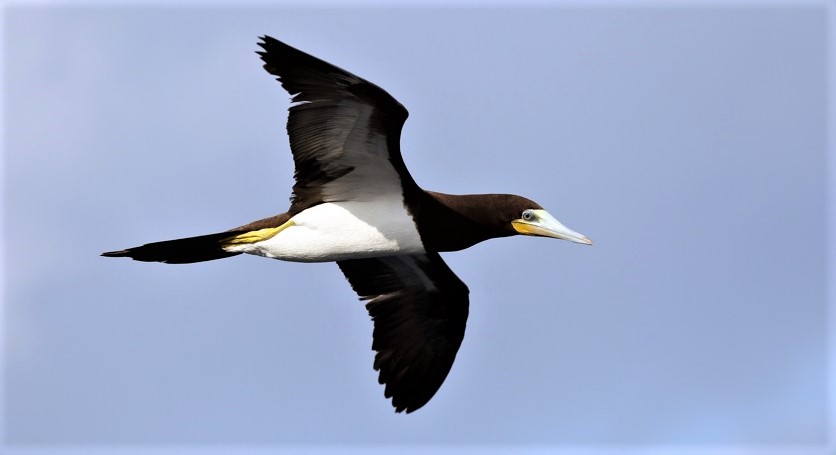
Brown
Booby off St. Vincent.
Photo by Yves-Jacques Rey
Millet
Day
3 - ST. VINCENT / ST. LUCIA
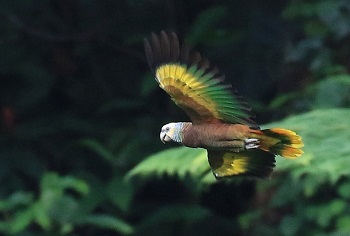 Today
we have the privilege of
being one of the few groups
of people on the planet
to observe large numbers
of St.
Vincent Parrots filling
the skies above us. We
leave our hotel at 4:30
am (packed breakfast
in our bags) to make for
an area known only to
select local forestry
officers. We'll visit secret site, deep in
the heart of the densely-forested
north and strategically
select our spots atop
a high ridge and from
there wait for the raucous
parrots to emerge from
their roosts in the verdant
forests around us. The St.
Vincent Parrot (Photo:
Keith Clarkson) is a species that was
long
on the verge of extinction
and is still listed
on the IUCN most threatened
species on the planet,
so the opportunity
to have incredibly close
views of this number
of wild birds in their
natural habitat is
one of the highlights
of the trip.
Today
we have the privilege of
being one of the few groups
of people on the planet
to observe large numbers
of St.
Vincent Parrots filling
the skies above us. We
leave our hotel at 4:30
am (packed breakfast
in our bags) to make for
an area known only to
select local forestry
officers. We'll visit secret site, deep in
the heart of the densely-forested
north and strategically
select our spots atop
a high ridge and from
there wait for the raucous
parrots to emerge from
their roosts in the verdant
forests around us. The St.
Vincent Parrot (Photo:
Keith Clarkson) is a species that was
long
on the verge of extinction
and is still listed
on the IUCN most threatened
species on the planet,
so the opportunity
to have incredibly close
views of this number
of wild birds in their
natural habitat is
one of the highlights
of the trip.
After our wonderful dawn encounter with the parrots, we descend the mountain, pulling over at select sites where the seemingly ever-present mangoes and guavas prove an irresistible lure to the St. Vincent Tanager (split in 2019 from the Lesser Antillean Tanager), Spectacled Thrush, Smooth-billed Ani and even Yellow-bellied Elaenia (feasting on fruit flies drawn to the ripening fruit).
After the early start, we return to our hotel to relax by the pool or stroll along the spectacular beaches that line this coast. We have lunch at the beach side restaurant and gaze out across the turquoise waters at Brown Pelicans, Royal Terns and Brown Boobies, before making the short ten-minute drive to the airport.
Following a 20-minute, mid-afternoon flight, we touch down in spectacular St. Lucia. We drive slowly en route to our hotel, pausing at a reliable site for Black Swift, before visiting the quaint seaside village of Dennery. Here we have the opportunity to experience the intense bartering culture engrained in and practiced by generations of local fishermen who line the pier in anticipation of returning boat crews. From Dennery, we make for a large sedge-filled wetland and, having timed our arrival with the setting of the sun, delight in the activities of Pied-billed Grebe, the Caribaea morph of American Coot, fly-bys of Belted Kingfishers and fabulous views of a host of over-wintering waders, waterfowl and herons all bathed in a soft orange glow.
Our
stay on St. Lucia is
at a serene locally-run
Inn, nestled among lush
hillsides and gardens
teeming with tropical
flowers. Here we can take
a swim in the pool before
dinner – enjoyed
on the candlelit outdoor
balcony with a breathtaking
view of glittering Praslin
Bay.
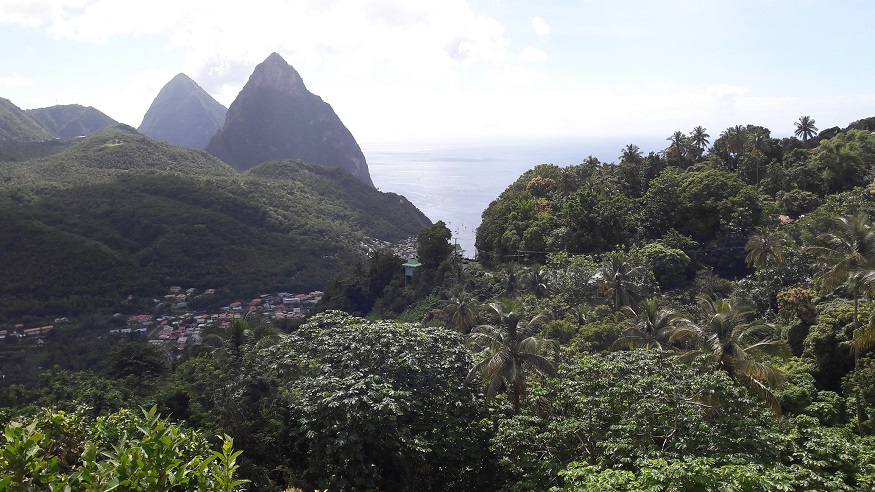
Les
Pitons, St. Lucia by
Ryan Chenery
Day
4 – ST
LUCIA
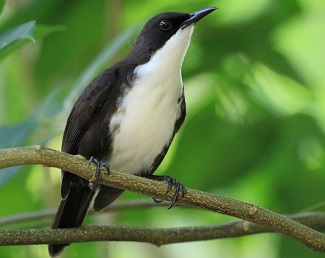 The
following morning we
enjoy a leisurely breakfast
before making the short
drive to see one of
the last thriving populations
of the threatened near
endemic White-breasted
Thrasher (Photo:
Keith Clarkson).
Some
research suggests
this is indeed a full
endemic St. Lucia
Thrasher and the bird
on Martinique
is an entirely separate
species. Other
inhabitants of this
dry forest include
the Lesser
Antillean Saltator,
curious
Mangrove Cuckoo and
endemic St.
Lucia Blackfinch.
The
following morning we
enjoy a leisurely breakfast
before making the short
drive to see one of
the last thriving populations
of the threatened near
endemic White-breasted
Thrasher (Photo:
Keith Clarkson).
Some
research suggests
this is indeed a full
endemic St. Lucia
Thrasher and the bird
on Martinique
is an entirely separate
species. Other
inhabitants of this
dry forest include
the Lesser
Antillean Saltator,
curious
Mangrove Cuckoo and
endemic St.
Lucia Blackfinch.
Following our time here we make for a tiny local hillside village where we learn from local Rastafarians of the many uses and local remedies of native flora. We then continue on to a unique ecotone known to harbor many of the island's indigenous and endemic species. It is no exaggeration to state that here numerous target species of birds will join the myriad Gulf Fritillaries, Cloudless Sulphurs, and Great Southern Whites flitting all around us. Overhead, Lesser Antillean Swifts effortlessly manipulate the air currents; among the trees colorful St. Lucia Warblers peer underneath leaves in search of caterpillars; overhanging tree limbs represent perfect vantage points for Lesser Antillean Flycatchers and St. Lucia Pewees to launch attacks on winged insects; and an abundance of fruits ripening in the tropical sun prove an irresistible lure for opportunistic St. Lucia Orioles.
Before
we head back to our hotel
we travel to a reliable
location on the island
for an audience with one
of the most difficult of
endemics to see on the
island
-
The St.
Lucia Nightjar!
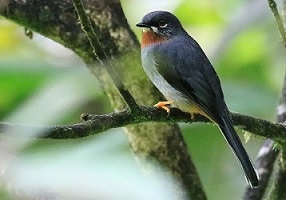
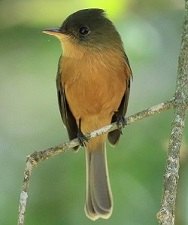
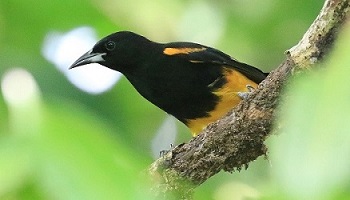
St.
Lucia specialties: Rufous-throated
Solitaire, St. Lucia Pewee,
St. Lucia Oriole. Photos
by Keith Clarkson.
Day
5 – ST.
LUCIA
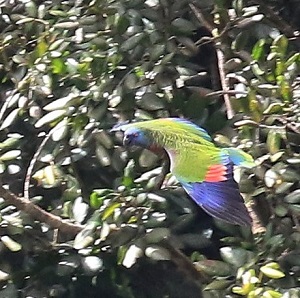 Today
we awake to a packed breakfast
and pre-arranged transport
waiting to take us to the
island’s
showpiece natural attraction – the
Des Cartiers
Rainforest. Des Cartiers
is dominated by numerous
trees endemic to the region
(including the majestic
and aromatic Lansan), along
with gargantuan Tree Ferns,
tiny bromeliads and orchids.
We spend a wonderful morning
here, walking the well-maintained
trails and identifying
the wondrous diversity of
flora all around us.
Today
we awake to a packed breakfast
and pre-arranged transport
waiting to take us to the
island’s
showpiece natural attraction – the
Des Cartiers
Rainforest. Des Cartiers
is dominated by numerous
trees endemic to the region
(including the majestic
and aromatic Lansan), along
with gargantuan Tree Ferns,
tiny bromeliads and orchids.
We spend a wonderful morning
here, walking the well-maintained
trails and identifying
the wondrous diversity of
flora all around us.
Our forest walk culminates at an observation area where we are afforded excellent views of the island’s national bird, and most colorful of all Amazonas – the magnificent St. Lucia Parrot (Photo: Keith Clarkson). At this site we are also in the presence of myriad other deep forest dwellers. The haunting ethereal song of the Rufous-throated Solitaire and the high-pitched note of the Lesser Antillean Euphonia are intermingled with appearances by near endemic Grey Tremblers and Caribbean Elaenias.
From the forest we make for the scenic and spectacular west coast where we lunch at what is surely the restaurant with the best view on the island of the majestic twin spires of Les Pitons, before winding our way down into historic Soufriere. Here, isolated groves of drought tolerant trees line the small secondary roads of this coastal habitat, and we target one of 6 subspecies of Antillean House Wren endemic to individual islands in the Lesser Antilles. On St. Lucia it is Troglodytes aedon mesoleucus.
We finish the day atop one of the island’s highest peaks where we are treated to the spectacular aerial acrobatics of a colony of Red-billed Tropicbirds.
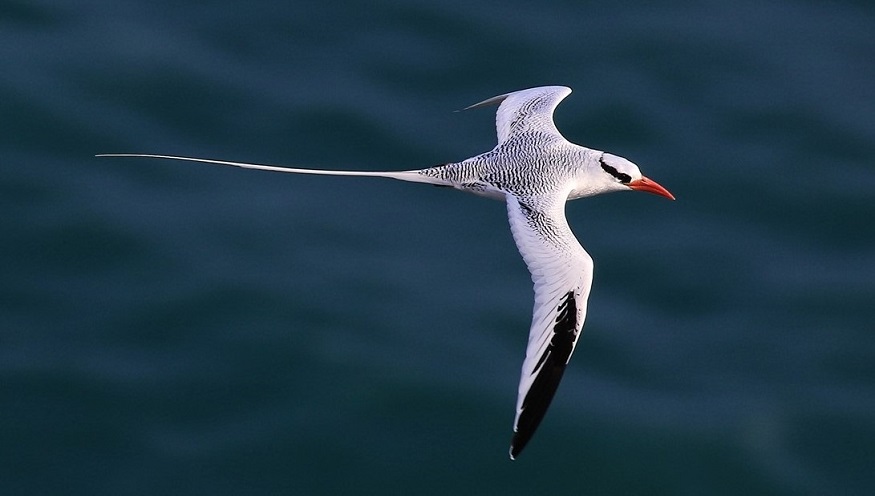
Red-billed
Tropicbird by Keith Clarkson
Day
6 - GRENADA
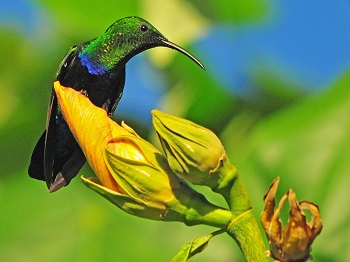 Today
sees us make the short “island-hopper” flight
to the southernmost of the
islands on our trip – the
Spice Isle of Grenada. From
the air, this small and
densely populated island
might seem an odd destination
on a birding trip, however,
by virtue of our making
for one of the last remaining
vestiges of suitable habitat
in the south of the island,
we are soon provided with
the opportunity to see the
rarest species of the entire
trip – the Grenada
Dove.
Today
sees us make the short “island-hopper” flight
to the southernmost of the
islands on our trip – the
Spice Isle of Grenada. From
the air, this small and
densely populated island
might seem an odd destination
on a birding trip, however,
by virtue of our making
for one of the last remaining
vestiges of suitable habitat
in the south of the island,
we are soon provided with
the opportunity to see the
rarest species of the entire
trip – the Grenada
Dove.
Latest counts estimate the surviving number of Grenada Doves to be as low as 140 individual birds. However by drawing on experience and knowledge amassed over numerous previous trips, our local guide will give you the best opportunity to be treated to a sight few people will have a chance to enjoy in their lifetime.
After visiting the last stronghold of this delicate unassuming dove, we explore the dry woodland that represents its natural habitats and here are treated to views of the “Spice Isle’s” other key inhabitants, including the Rufous-breasted Hermit, endemic subspecies of Green-throated Carib (Photo: Sam Barone), and the other full species recently split from the Lesser Antillean Tanager – the Grenada Tanager. We finish the day by climbing a well-positioned observation tower to scan the skies for the local race of Hook-billed Kite.
Our lodgings for the night will be a vibrantly colored and newly refurbished local resort.
Day
7 - DOMINICA
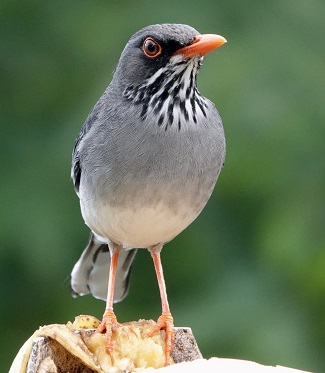 This
morning we take a short
flight to Dominica - an
island regarded by many
as the "Nature
Lover's Caribbean Island".
With her innumerable waterfalls
and a river for every day
of the year coursing through
her vast tracts of primary
rainforest, Dominica offers
a snapshot into what many
of the more developed islands
of the region would have
resembled in years gone
by.
This
morning we take a short
flight to Dominica - an
island regarded by many
as the "Nature
Lover's Caribbean Island".
With her innumerable waterfalls
and a river for every day
of the year coursing through
her vast tracts of primary
rainforest, Dominica offers
a snapshot into what many
of the more developed islands
of the region would have
resembled in years gone
by.
Upon arrival, we pause at a popular roadside stand to sample a selection of homemade tamarind and golden apple juices, before our vehicle begins its climb high into the Northern Forest Reserve. We will not have been traveling far before the mellifluous calls of an array of wondrous Lesser Antillean species gives us cause to pull off the dusty track to investigate. Upon doing so we are immediately met with a veritable barrage of sightings of near endemics and birds indigenous to the region. Birds including Lesser Antillean Pewee and Zenaida Dove should offer excellent views by perching conspicuously in sparsely leafed mangoes; Brown Tremblers (one of an entire genera confined exclusively to the Lesser Antilles), arrive on the scene to without hesitation lift their wings, cock their heads and start to TREMBLE; and pairs of delicate Plumbeous Warblers, whose excited trill calls greet their every leap along the creeping vines dangling tantalizingly close to our heads.
As our van climbs ever-higher along the track, we scan the roadside for Eastern Red-legged Thrush (Photo: Mark Greenfield) – the subspecies albiventris a near endemic, as well as two members of the Mimid family - the largely common Tropical Mockingbird (subspecies antillarum endemic to the Lesser Antilles) and the less often seen Scaly-breasted Thrasher.
Later today sees us travel into the Carib territories. These eight villages represent the last remaining stronghold of a people who once traveled and eventually settled throughout the Lesser Antilles and who still follow many of the customs and practices of their ancestors. This visit gives us an incredible insight into the lives of many of the Lesser Antilles original inhabitants, allows us to delight in their culture and arts and enjoy a traditional Carib meal in one of the villages before making the short drive to our coastal accommodation.
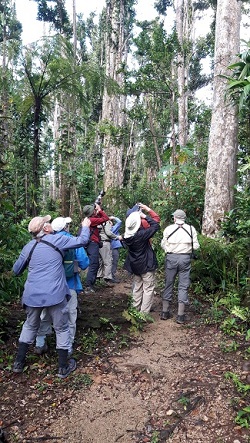 Day
8 - DOMINICA
Day
8 - DOMINICA
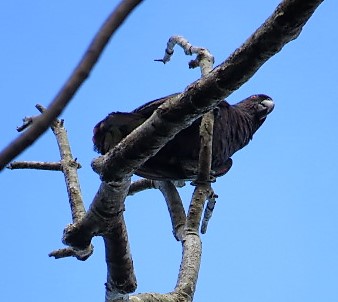 This
morning we wake to the
smell of rich Dominican
coffee as we set off before
dawn in order to give ourselves
the best opportunity to
see one of the rarest species,
not only in the region
but on the entire planet – the
majestic Imperial
Amazon (Photo
by Terry
Anderson).
Perched overlooking
deep
verdant valleys and
with
the distant sound of
thunderous rivers coursing
far below us, we scan
the canopies of towering
emergents for the undoubted
monarch of this land.
It’s
more gregarious “cousin” the
Red-necked Amazon provides
more frequent entertainment
as small flocks awaken
to flutter from one
fruiting
tree to another, while
behind us, the trapline
habits of the near-endemic
Blue-headed Hummingbird
ensure that we regularly
turn our attention
to small groves of Costus
spictatus. Fifty-five
species of butterfly
including regional
endemics such
as Dominican Hairstreak,
Godman’s
Hairstreak, Godman's
Leaf
and St. Lucia Mestra
have
been recorded on
Dominica,
and these, along
with the
more wide-ranging
Caribbean
Buckeye and Cassius
Blue
ensure that our
eyes
are
drawn to every sunlit
area
during our exhilarating
day in the forest.
This
morning we wake to the
smell of rich Dominican
coffee as we set off before
dawn in order to give ourselves
the best opportunity to
see one of the rarest species,
not only in the region
but on the entire planet – the
majestic Imperial
Amazon (Photo
by Terry
Anderson).
Perched overlooking
deep
verdant valleys and
with
the distant sound of
thunderous rivers coursing
far below us, we scan
the canopies of towering
emergents for the undoubted
monarch of this land.
It’s
more gregarious “cousin” the
Red-necked Amazon provides
more frequent entertainment
as small flocks awaken
to flutter from one
fruiting
tree to another, while
behind us, the trapline
habits of the near-endemic
Blue-headed Hummingbird
ensure that we regularly
turn our attention
to small groves of Costus
spictatus. Fifty-five
species of butterfly
including regional
endemics such
as Dominican Hairstreak,
Godman’s
Hairstreak, Godman's
Leaf
and St. Lucia Mestra
have
been recorded on
Dominica,
and these, along
with the
more wide-ranging
Caribbean
Buckeye and Cassius
Blue
ensure that our
eyes
are
drawn to every sunlit
area
during our exhilarating
day in the forest.
Dinner is enjoyed tonight from the balcony of our coastal cliff top hotel.
Day
9 - GUADELOPE
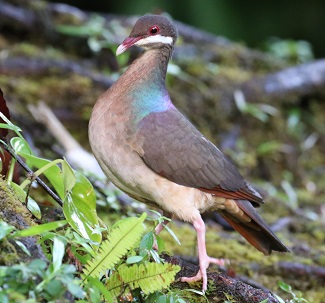 We
follow our time on Dominica
with a boat journey across
to the first of two French
Overseas Territories in
the island chain. Guadeloupe
is a remarkable island,
for its forests not only
provide glimpses of some
of the more secretive species
rarely seen on other islands
as evidenced by the Bridled
Quail Doves (Photo:
Beatrice Henricot) walking
at our feet and nominate
race of the regional
endemic Forest
Thrush hopping
along select roadsides!
Hopefully, we get
very close to a most
curious endemic indeed.
The movements of the Guadeloupe
Woodpecker are
somewhat unconventional,
with birds often
seen
dangling upside
down
directly overhead
while
clinging to slender
swinging branches
and plucking ants
from
clusters of berries!
Odd? Yes. But it
certainly
allows for fabulous
views!
We
follow our time on Dominica
with a boat journey across
to the first of two French
Overseas Territories in
the island chain. Guadeloupe
is a remarkable island,
for its forests not only
provide glimpses of some
of the more secretive species
rarely seen on other islands
as evidenced by the Bridled
Quail Doves (Photo:
Beatrice Henricot) walking
at our feet and nominate
race of the regional
endemic Forest
Thrush hopping
along select roadsides!
Hopefully, we get
very close to a most
curious endemic indeed.
The movements of the Guadeloupe
Woodpecker are
somewhat unconventional,
with birds often
seen
dangling upside
down
directly overhead
while
clinging to slender
swinging branches
and plucking ants
from
clusters of berries!
Odd? Yes. But it
certainly
allows for fabulous
views!
The lush forests of Guadeloupe also represent a favored over-wintering site for a variety of North American warblers, and with the timing of our tour, we are almost certain to encounter such species as American Redstart, Prothonotary Warbler, Chestnut-sided Warbler, Blackpoll Warbler and others during our birding here.
Our cottages surrounded by swaying palms and flowering bougainvillea offer the perfect post-birding relaxation spot. Dinner tonight is a wonderful blend of French cuisine and Carib-Creole influence.

Forest
Thrush by Beatrice Henricot
Day
10 - MONTSERRAT
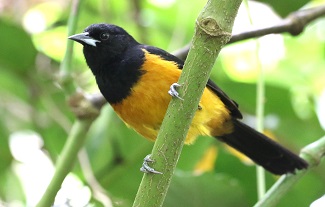 Widely
known as the Second Emerald
Isle, one can circumnavigate
Montserrat by foot and
never once step outside
of the lush expanse of dense
primary forest that dominates
this magical island. This
is a largely unspoiled
land
with the volcanic eruption
of 1995 rendering half
of the island uninhabitable,
covered in magma, and causing
a significant proportion
of the population to emigrate.
But what remains is quite
simply stunning. The volcano
itself still smolders,
but is constantly monitored
by volcanologists who have
declared the other half
of this sparsely populated
island completely safe
for residents and visitors
alike. Thankfully this
is also the half of the
island where we find our
target bird species! The
striking Montserrat
Oriole (Photo:
Beatrice
Henricot) is
our number one target,
and we walk the paths
of this ancient forest,
dominated by huge emergents
and long swinging lianas,
until we come to reliable
stands of giant heliconias...for
it is these that represent
our best site for seeing
orioles. As we have ensured
we are on the island
during
nesting season, it is
highly likely that such
stands will reveal both
the olive-green female
and fiery-breasted male!
Widely
known as the Second Emerald
Isle, one can circumnavigate
Montserrat by foot and
never once step outside
of the lush expanse of dense
primary forest that dominates
this magical island. This
is a largely unspoiled
land
with the volcanic eruption
of 1995 rendering half
of the island uninhabitable,
covered in magma, and causing
a significant proportion
of the population to emigrate.
But what remains is quite
simply stunning. The volcano
itself still smolders,
but is constantly monitored
by volcanologists who have
declared the other half
of this sparsely populated
island completely safe
for residents and visitors
alike. Thankfully this
is also the half of the
island where we find our
target bird species! The
striking Montserrat
Oriole (Photo:
Beatrice
Henricot) is
our number one target,
and we walk the paths
of this ancient forest,
dominated by huge emergents
and long swinging lianas,
until we come to reliable
stands of giant heliconias...for
it is these that represent
our best site for seeing
orioles. As we have ensured
we are on the island
during
nesting season, it is
highly likely that such
stands will reveal both
the olive-green female
and fiery-breasted male!
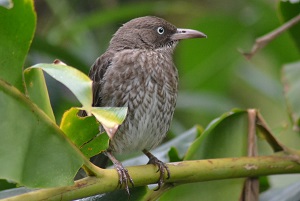 Although
Montserrat is home to this
single-island endemic,
it is also the best island
for honing in on a species
of thrasher that can prove
difficult on other islands. Pearly-eyed
Thrashers (Photo:
Ryan Chenery) are
abundant on Montserrat
and can be approached
relatively closely both
within, and on the outskirts
of the forest. Another
target and one which
will require far more
patience is the island’s
endemic subspecies of
Forest Thrush.
Although
Montserrat is home to this
single-island endemic,
it is also the best island
for honing in on a species
of thrasher that can prove
difficult on other islands. Pearly-eyed
Thrashers (Photo:
Ryan Chenery) are
abundant on Montserrat
and can be approached
relatively closely both
within, and on the outskirts
of the forest. Another
target and one which
will require far more
patience is the island’s
endemic subspecies of
Forest Thrush.
As we continue our walk through this picturesque habitat, it is clear that the forest floor can be just as alive as the trees above. Leaves rustle everywhere - Montserrat’s Anolis lizards scuttle across the ground and clamber up tree trunks, the non-venomous and exceptionally rare Montserrat Racer warms itself in patches of sunlight, and unbelievably, tiny Dwarf Geckos no bigger than the tip of your thumb study us with big googly eyes as they peak out from beneath the “giant” fallen leaves on the path before us.
Back
at our local lunch spot,
we sit back relax and
celebrate the day’s
birding with a hearty meal
and wash it down with a
local specialty – Bush
Rum! No sugar cane used
in this one – only
select local herbs and
plants gathered from the
forest!
Day
11 - MARTINIQUE
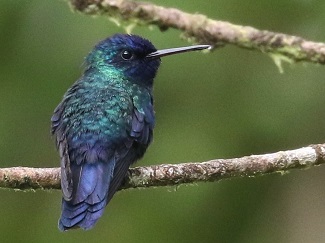 With
our packed breakfast on
board with us, we make for
the stunning and heavily
forested other French Territory
in the region - Martinique.
By this stage in our travels
along the island chain,
any prior belief that a
visit to one Lesser Antillean
island is akin to visiting
another will have vanished.
The stark differences in
topography, geology, and
the ethnic and cultural
differences to be found
among the populations ensure
that a visit to the islands
of the Lesser Antilles is
very much an exploration
of ten very individual and
unique islands.
With
our packed breakfast on
board with us, we make for
the stunning and heavily
forested other French Territory
in the region - Martinique.
By this stage in our travels
along the island chain,
any prior belief that a
visit to one Lesser Antillean
island is akin to visiting
another will have vanished.
The stark differences in
topography, geology, and
the ethnic and cultural
differences to be found
among the populations ensure
that a visit to the islands
of the Lesser Antilles is
very much an exploration
of ten very individual and
unique islands.
Here on Martinique, the small bistros and cafes that line the main courtyard of the thriving capital city of Fort-de-France and the feverish games of boules played on well-manicured pitches is unlike anything we’ve seen on previous islands and is testimony to an unquestionable Franco-influence.
This
remarkable and heavily
forested island is the oldest
in the Lesser Antilles,
and it therefore makes
sense
that it is here that we
come across the nominate
of three of those species
that have over millennia
filtered out to other islands.
But the island also boasts
a stunning single-island
endemic in Icterus
bonana (the Martinique Oriole).
While birding in some
truly spectacular primary
forest, we will also
be looking for Black-whiskered
Vireo and Blue-headed
Hummingbird (Photo:
Beatrice Henricot) in
case this delightful
near endemic hummer
proved elusive in Dominica,
as well as targeting
the striking rufous-hooded
endemic subspecies of Golden
Warbler and Ruddy
Quail Dove.
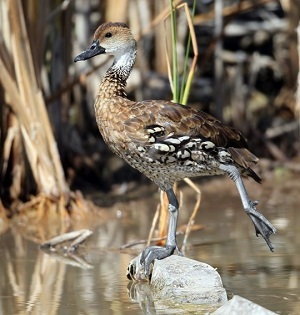 Day
12 - ANTIGUA
Day
12 - ANTIGUA
Today,
we take a flight to sun-kissed
Antigua – the
island with a beach for
every day of the year.
Upon arrival in the early
afternoon, we are collected
by pre-arranged transport
and driven to our historic
Inn on the outskirts of
the capital of St. Johns.
The extensive and heavily
treed grounds of the Inn
provide the perfect setting
for an introduction to
Antigua’s
specialties including
the
endemic subspecies of Caribbean
Elaenia and Broad-winged
Hawk as
well as nominate
of Pearly-eyed
Thrasher. As
the sun gets lower
in
the sky we take a
drive
to a nearby thriving
wetland
where we do some
leisurely
birding, focusing
on a number of overwintering
waders, waterfowl
and herons. As dusk
approaches there
is even the chance
of an encounter with
small flocks of West
Indian
Whistling Duck (Photo:
Yves-Jacques Rey
Millet).
After returning to the hotel we enjoy a swim in the large pool before tucking into a Caribbean-themed dinner. We are later treated to live entertainment featuring steel pans and cultural dance enjoyed with a wide selection of cocktails.
The following morning we make for Antigua’s sister island of Barbuda.
Day
13 - BARBUDA
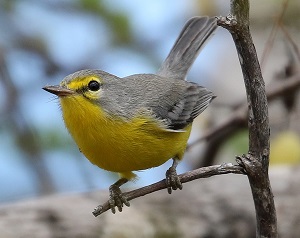 After
breakfast enjoyed with
views of White-crowned
Pigeons feeding in the crowns of
swaying palm trees, we
head to Antigua’s
Main Port, where we embark
on a day trip to the smaller
sister of this twin-island
state. We board our vessel
and are soon jetting across
some of the most beautiful
waters in the Caribbean
Sea.
After
breakfast enjoyed with
views of White-crowned
Pigeons feeding in the crowns of
swaying palm trees, we
head to Antigua’s
Main Port, where we embark
on a day trip to the smaller
sister of this twin-island
state. We board our vessel
and are soon jetting across
some of the most beautiful
waters in the Caribbean
Sea.
Arriving into Barbuda one can immediately see the stark contrast between the heavily developed and well-established tourist destination of Antigua and this little visited island, where vast stretches of undisturbed beaches, sheltered coves and dry coastal forests support a very different cast of characters to those previously encountered on our trip. Our main target here is the diminutive Barbuda Warbler (Photo: Beatrice Henricot). This charming warbler is perfectly at home in the dry scrublands of one of the Lesser Antilles driest islands and shares the habitat with species such as Common Ground Dove, Eared Dove, White-winged Dove, Black-faced Grassquit, Lesser Antillean Iguanas, and bizarrely... herds of feral donkeys!
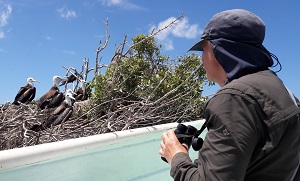 Barbuda
is also home to the largest
Magnificent
Frigatebird (Photos:
Ryan Chenery) colony
in the entire Caribbean.
These giants are most
commonly seen soaring high
above the waves, carefully
scanning the waters for
food floating on or close
to the surface. So it
is a wonderful treat to
board a dinghy that takes
us across a shallow lagoon
absolutely teeming with
marine life (as evidenced
by the hundreds of jellyfish
of every shape and size
floating beneath us and
clearly visible from our
bough) and moors us literally
within touching distance
of thousands of nests,
chicks and adults. We
spend half an hour in the
presence
of these incredible birds,
observing their behavior
and watching as squadrons
of adults manipulate their
impressive 6-foot wingspan
to return with food to
perch beside their young.
Barbuda
is also home to the largest
Magnificent
Frigatebird (Photos:
Ryan Chenery) colony
in the entire Caribbean.
These giants are most
commonly seen soaring high
above the waves, carefully
scanning the waters for
food floating on or close
to the surface. So it
is a wonderful treat to
board a dinghy that takes
us across a shallow lagoon
absolutely teeming with
marine life (as evidenced
by the hundreds of jellyfish
of every shape and size
floating beneath us and
clearly visible from our
bough) and moors us literally
within touching distance
of thousands of nests,
chicks and adults. We
spend half an hour in the
presence
of these incredible birds,
observing their behavior
and watching as squadrons
of adults manipulate their
impressive 6-foot wingspan
to return with food to
perch beside their young.
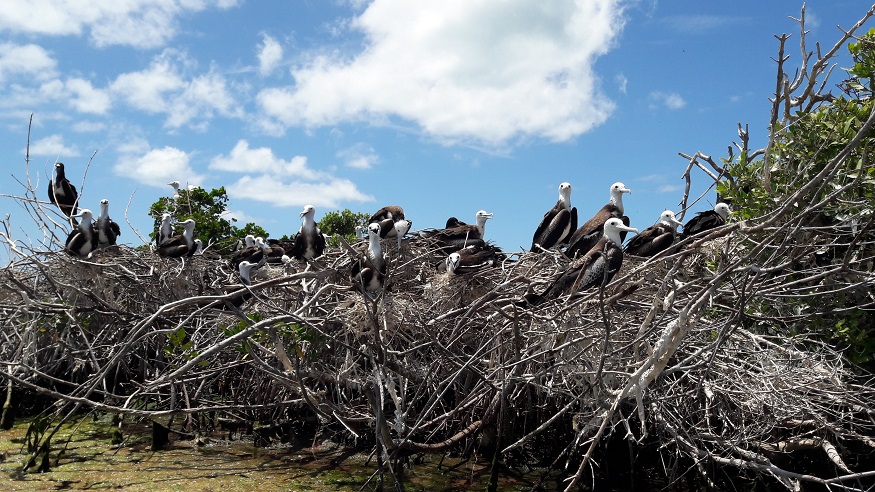
Driving around the island one cannot help but be struck by the spectacular and unspoiled natural beauty of Barbuda. This is “postcard perfect”. The water is a glistening turquoise blue and the colors of the sands effortlessly blend between brilliant whites and varying shades of pink. With some of the most untouched beaches in the Caribbean literally on either side of us, what better way to spend the rest of the day than to head to a charming “Robinson Crusoe-esque” beach bar to enjoy an absolutely delicious meal of mahi mahi, chicken or lobster, and follow it up with a relaxing swim or snorkel in shallow waters and a stroll along an idyllic white sand beach known to be frequented by Royal as well as Least Tern. This truly is a case of Birding in Paradise!
 On
our return leg across the
sun-kissed seas to Antigua,
we may have the opportunity
for dolphin and whale encounters.
On
our return leg across the
sun-kissed seas to Antigua,
we may have the opportunity
for dolphin and whale encounters.
Back at base, standing on the veranda after yet another delicious Creole dinner, we go over the extensive and varied trip-list while casting our eyes out at the moonlit Caribbean Sea that for two weeks we have journeyed across. What better way to reflect on our travels and draw to a close our adventures in the magical islands of the Lesser Antilles.
Grey
Trembler. Photo by Jane
Hartline.
Day
14 – DEPARTURES
FROM ANTIGUA
Buffet
breakfast and homeward journey.
Departures are from V. C.
Bird International Airport
in Antigua (Airport code:
ANU)
PLEASE NOTE: Our exact route through the islands may vary, as we identify the most practical and time efficient order in which to go through the 10 islands (based on the most recent flight schedules and boat operators timetables). Rest assured we will cover everything in the itinerary and we will alert you to any changes ahead of the tour.
| LESSER
ANTILLES 10 ISLAND ENDEMIC BIRDING TOUR January 11 - 24, 2027 Registration Form> TOUR PRICE: US$ TBA (2024 price: $8495) per person based on double occupancy and a minimum of 7 clients. This tour will fill quickly. Email us to hold your space. Note this tour begins in Barbados at Grantley Adams International Airport (Airport code: BGI) and ends in V. C. Bird International Airport in Antigua (Airport code: ANU). Single
supplement: US$ TBA
per
person.
Subject
to
availability. Not included: International flight, passport fees, departure taxes, insurance, drinks, laundry, tips, and items of a personal nature. Note: The tour price is based on a minimum of 7 passengers. If there are less than 7, a small group supplement may be charged. Also, any and all costs arising from pandemic or Covid-19 related issues are not included in the tour cost and are the sole responsibility of the traveler. These include, among others, the costs of Covid treatment, hospitalization, medical fees, transport, meals and accommodation in case of illness or quarantine, and the costs of any Covid tests needed before, during and after the tour.
Once the tour is confirmed to go ahead, we will send you information about booking your flights. Please do not book flights until you receive this information from us and are notified that the trip has sufficient numbers to run. Additional deposits will be due once the tour is confirmed to go ahead. Final payment is due September 11, 2026. **Please note: Tour prices are based on quoted costs from ground operators (in their local currency), estimated fuel costs, and the rate of exchange the time of itinerary publication. The erratic nature to global financial markets makes it difficult to predict changes in costs and foreign currency exchange rates over the long term. Since tours are priced well in advance of the actual operation of the tour, tour costs, fuel costs and exchange rates can change, sometimes drastically. Depending on the extent of such changes, it may be necessary to implement a surcharge on this tour. If a surcharge is necessary, every effort will be made to minimize the amount. Cancellations
and Refunds:
TRIP
INSURANCE: PLEASE NOTE:
Questions? Contact Gina Nichol at gina@sunrisebirding.com Phone: 203.453.6724 |
